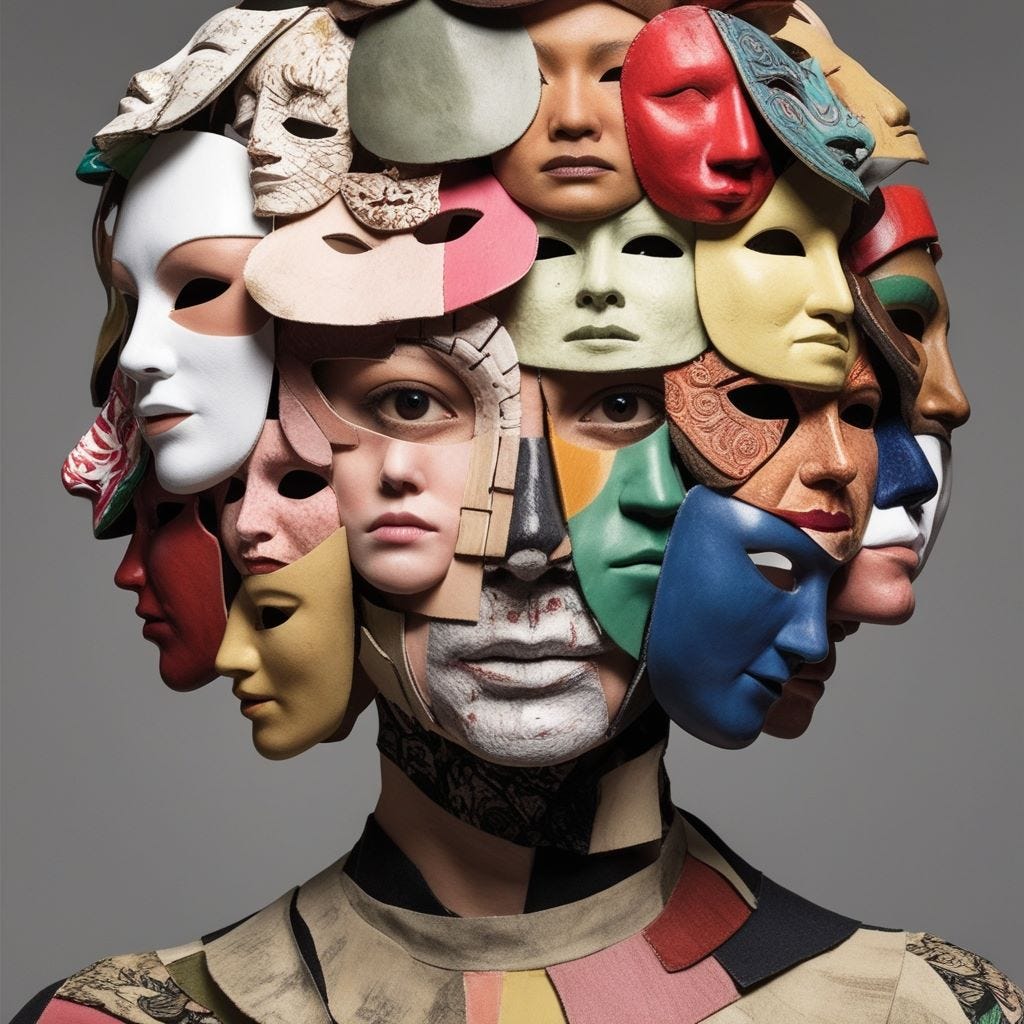The Identity You're Trying to Kill Won't Die Because You'll Defend It to Your Last Breath
Don't hate parts of yourself because they are teachers you haven't learned from yet
We all have parts of ourselves we don’t want to claim.
The identities that speak badly of who we should be. Masks we wear that make us uncomfortable when we notice them.
The common solution? Obliterate the parts we don’t like. Keep only the acceptable pieces.
But here’s what we don’t understand—you never know how deeply an identity is rooted until you try to let it go.
“One does not become enlightened by imagining figures of light, but by making the darkness conscious.” — Carl Jung
We Cling to Identities Like Life Rafts
We use identities to define who we are in the world.
They’re filters through which we see everything. Lenses that tell us what’s safe, what’s dangerous, what’s possible. Who we think we are.
Without them, the world becomes terrifying.
How do you navigate reality when there’s no filter telling you who you are? What do you believe about yourself without definitions? How do we interact with people without boundaries?
Our identities are everything we base our self-knowledge on.
Most identities we cling to come from our past. Childhood experiences, trauma, moments that shaped how we see ourselves. We outgrow these identities without ever realizing it.
But we keep wearing them anyway.
The victim. The health-challenged one. The aggressor. The bully. The love-starved person always searching.
It can also be your job as nurse, scientist, teacher, social worker.
Or your creative identity as artist, writer, spiritual seeker.
We don’t hold just one identity. They’re like masks we wear and change as often as needed. Each situation gets its own mask. Each relationship, each challenge, each moment of uncertainty.
But here’s the thing—we are so much bigger than our masks.
A mask is only one facet of the diamond we are. There are so many facets to ourselves we might never discover them all in this lifetime.
When Identities Become Prison Cells
Identities become outdated when they hamper us from living our best life.
We can slip into an identity honestly, without meaning to. It happens so naturally we don’t even notice.
There are identities from the ego and identities from our true selves.
Ego identities are dangerous. They’re not real. They’re façades to distract you from what the world really looks like. They are the face we show the world.
True self identities are the personalities we slip into. From family roles to personal identities to public personas. We feel like we’re shapeshifting as we enjoy these identities.
My favorite ego identity to play for so many years was the prostitute.
Not the literal sense—the archetype. The pattern underneath.
I believed that everything in life costs something. Nothing was free. I had to give part of myself to gain anything for myself.
The Cost of Everything
The prostitute identity showed up everywhere in my life.
The obvious payment system was dangerous enough—constantly bartering pieces of myself for scraps of what I needed.
But the real damage was deeper.
Not letting myself shine. Hiding parts of myself. Never asking for help freely because everything had to be a transaction. The bartering never came out in my favor. I always gave so much away for so little gain.
I hoarded my treasures close to my heart. The gifts, the dreams, the parts of me that felt most precious—and never gave them the attention or energy they needed to grow. I hid myself away.
Because if I showed these parts, someone would demand payment for acknowledging them.
It was a payment I was sure was too high. If I had to pay for them, then they were not my treasures anymore but blackmail for other people to use over me.
I’m still working on getting better at this.
You Can’t Kill What’s Part of You
I was going to say here I crushed this identity and live without it.
It’s not the truth though. We can’t kill a part of ourselves no matter how much we want to. There are no good and bad parts of ourselves.
Judgment of these parts causes fractures.
Fractures argue with each other inside of us.
Now there is a voice that is right and wrong. If you get enough of these fractures, you start getting an internal war. You will never have peace this way.
The only way to stop the war is to accept the internal parts of yourself that are there.
“There are no bad parts. All parts have positive intent, even if their actions are counterproductive.” — Richard Schwartz
So how do you actually do this? How do you see an identity clearly enough to learn from it?
This turning point came when I started to see this identity in action. To watch how it played out in my daily life.
Recently, I found myself falling back into the prostitute pattern. I let people dictate my time throughout the day instead of doing what I wanted.
Like I had to pay for time on my own by following other people’s schedule.
That’s when I caught it. I chose how to spend my time doing the things that I wanted instead.
The First Step Is Seeing It
To see an identity in action, I had to start with how much I valued myself. How much I loved myself.
This sets the tone for acceptance, not judgment.
Then I could see that I was not for sale. That I could live openly and didn’t have to hide what I wanted or how I wanted to live.
As I respected myself, I learned to respect others.
I gave people space as I gave myself space. I honored my boundaries and other people’s as well.
I stopped asking for more than people could give and started appreciating what they did share.
I gained wisdom from this part of myself.
From Mask to Facet
I did take the mask off—but I didn’t destroy it.
Instead, I let it become a facet I know about, a teacher I can learn from.
Now I know to check in with myself when I feel off because I might be falling back into old habits.
The prostitute identity taught me that I have the right to make choices based on my own priorities, not someone else’s. That I can work my own needs into a schedule not dictated by other people.
That my gifts aren’t currency. That asking for help doesn’t require payment. That I can shine without owing anyone an explanation.
These lessons only came because I stopped trying to kill this part of myself.
What Your “Bad” Identities Are Really Doing
When we act through an identity we don’t want to claim, there’s wisdom and self-knowledge to learn from it.
Changing a viewpoint can be enough to shed the mask and claim a facet of yourself.
There are no bad parts of yourself unless you give your ego permission to run them.
The identities you’re trying to destroy? They’re trying to protect you.
“Nothing ever goes away until it has taught us what we need to know.” — Pema Chödrön
They emerged for a reason. They served a purpose. They kept you safe when you needed safety.
The prostitute identity kept me from being vulnerable when vulnerability felt dangerous. It gave me a system for navigating a world that felt transactional and unsafe.
Was it healthy? No.
But it was what I had at the time.
How to Work With Unwanted Identities
Start by getting curious about which identities you’re carrying—both the ones you embrace and the ones you hide.
Notice when you feel “off” or unlike yourself. That’s often a clue you’ve slipped into an old identity pattern.
Ask yourself what is this identity trying to protect me from?
Then look for the wisdom. What did this pattern teach you about boundaries? About self-worth? About navigating relationships or challenges?
Try this. Journal about a moment when you felt unlike yourself. What identity had you slipped into? What was it protecting you from? What lesson was hidden inside it?
Accept it as a learning practice for yourself. Acknowledge that it was a part of you—maybe still is a part of you.
But now it can become a guidepost instead of a prison. A facet instead of a mask.
A teacher instead of an enemy.
You’re Just People With Quirks
We are all just people with quirks.
There are many parts of ourselves—some we like, some we don’t like.
“I’d rather be whole than good.” — Carl Jung
We can learn to love all parts of ourselves when we stop trying to kill the uncomfortable ones.
Your “bad” identities aren’t character flaws. They’re survival strategies that once served you.
Now they’re ready to teach you something deeper.





Wow. Great article! This touches on so many issues I've been having. I feel like I need to beat the parts of myself into submission. I find them "distracting", and they irritate me. Mostly because I feel like they remove me from the path of just being me. Acceptance is so difficult. It's taken me so long to get to the point where I'm starting to heal, and in my impatience, I want to annihilate anything in my way, or that I feel is in my way. More things to ponder on.
Again, right on the nose. I see myself in everything you write. A year of therapy has definitely taugt me to move in a new direction. Keep going, girl!